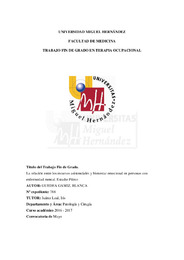Resumen :
Introducción. El porcentaje de personas en España que presentan un trastorno mental es del
15%, de los cuales, el 42.2 % se encuentra institucionalizado en un centro penitenciario, el
57.8% en otros recursos asistenciales que se encuentran implantados en España.
Objetivo. Determinar la relación entre el recurso asistencial y bienestar emocional en personas
con enfermedad mental.
Material y métodos. Es un estudio transversal descriptivo, donde se evaluaron la calidad de
vida mediante la Escala Integral CV, el apoyo social mediante el Cuestionario MOS de apoyo
social y la depresión/ansiedad mediante el Cuestionario Golderg-GH28. Se realizó en una
muestra de 22 sujetos que presentaban un trastorno mental y procedían de distintas instituciones
asistenciales, Foncalent (Alicante) y APAFA (Almería).
Resultados. En cuanto a la calidad de vida, existe una diferencia significativa entre los usuarios
de los diferentes centros, obteniendo mejores Foncalent (60.71%) y APAFA (35.71%).
Discusión. Las limitaciones del estudio fueron la muestra de tamaño reducido y la dificultad
para realizar el estudio en otras instituciones penitenciarias. Por ello, como líneas de futura
investigación, sería interesante recoger datos de una muestra mayor, en otras instituciones y
observar la influencia de otras actividades que realizan sobre la calidad de vida.
Conclusión. La hipótesis marcada en el estudio, no se ha podido cumplir ya los resultados
obtenidos sobre que la calidad de vida de los usuarios en el centro de Foncalent son mejores que
en APAFA. En cambio, los objetivos si se han cumplido.
Introduction. El percentage of persons in Spain that they present a mental disorder is 15 %, of
which, 42.2 % is become institutionalized in a penitentiary center, 57.8 % in other welfare
resources that are implanted in Spain.
Aim. Determine the relation between the aid resources and the emotional well-being of a person
with a mental illness.
Resources and methodology. A descriptive transversal research where life quality is evaluated
under the Integral Escale CV. Social support was evaluated the MOS Questionnaire. Depression
and anxiety were evaluated under the Golderg-GH28 Questionnaire. For the research 22 person
with a mental illness from different institutions, Foncalent (Alicante) and APAFA (Almería)
where chosen.
Results. Regarding life quality, there is a remarkable difference between patients depending on
the centre that they belong to. Foncalent (60.71%) and APAFA (35.71%).
Hypothesis.The limitations of the study were the sample of limited size and the difficulty to
realize the study in other penitentiary institutions. For it, as lines of future investigation, it
would be interesting to gather information of a major sample, in other institutions and to
observe the influence of other activities that they realize on the quality of life.
Conclusion.. The hypothesis support in the research has not been fulfilled since the results
about life quality of patients from Foncalent were better than those from APAFA. However,
other aims have been fulfilled.
|
 La licencia se describe como: Atribución-NonComercial-NoDerivada 4.0 Internacional.
La licencia se describe como: Atribución-NonComercial-NoDerivada 4.0 Internacional.
.png)
